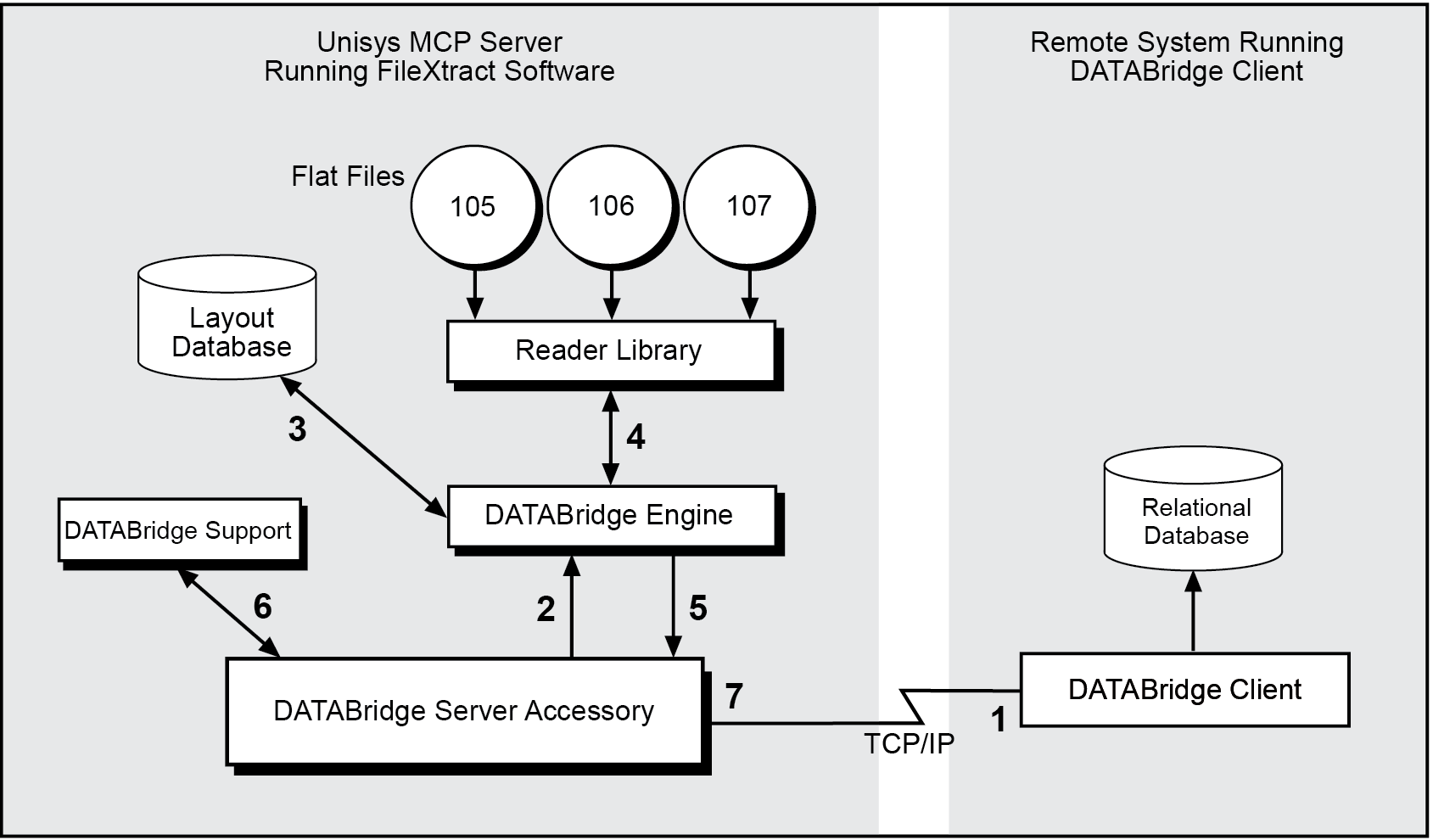Introducing FileXtract
Databridge FileXtract is a product which allows you to clone and update non-DMSII data (that is, flat files) residing on Unisys ClearPath NX, LX, or A Series mainframes. FileXtract is bundled with the Databridge Host software and includes several Reader libraries and other associated files.
FileXtract software is automatically installed as part of the Databridge host software, and has no additional system requirements.
You can use FileXtract in conjunction with the Databridge Client, DBSpan, or DBSnapshot. When using FileXtract with the Databridge Client, FileXtract data sources resemble any other DMSII data source. The following diagram shows how the Databridge Client uses FileXtract to replicate flat files.

- The Databridge Client calls the Databridge Server (DBServer) to replicate the specified flat files.
- DBServer calls the Databridge Engine (DBEngine) to extract the data for the selected flat files.
- The DBEngine accesses the specified FileXtract layout database to determine the layout of the flat files. No updates are actually done to this database. The Engine gets all of the layout information it needs from the DESCRIPTION file. The DMSII CONTROL file and the DMSUPPORT library will exist, but the data sets and audit files will not.
- DBEngine calls the appropriate Reader library, as specified in the layout database, to extract the data from the flat files.
- DBEngine sends the data to DBServer.
- DBServer calls Databridge Support to filter, alter, or transform the data, if needed.
- DBServer sends the data to the Databridge Client.
- The Databridge Client populates the relational database and then either waits for additional flat file information or terminates.
Advantages of FileXtract
FileXtract provides the following advantages:
-
Any type of flat file (non-DMSII data) can be replicated to a Client database
-
Sample Reader libraries are provided for system summary log files (SUMLOG), COMS Transaction Trail files (TTRAIL), printer backup files (PRINTFILES), BICSS log files (BICSS), LINC Activity logs (LINCLOG), and the USERDATA system file. You can use these sample Reader libraries without any modifications to the Reader libraries. DASDL files are provided to generate the corresponding layout database. For more information, see Using Reader Libraries.
-
The DISKFILE Reader library is provided to replicate COBOL created flat files. If you have COBOL 01-level file record descriptions for your flat files, you can use the COBOL-to-DASDL utility to generate the layout database. For more information, see Using the COBOL-to-DASDL Utility.
-
Sample Reader libraries are also provided to allow you to customize replication of any other type of flat file. For more information, see Using Reader Libraries.
-
-
Cloning is required only one time. After the flat files are cloned, FileXtract updates the Client database as new records and flat files become available.
-
Replicate only the parts you want from flat files. You don't have to replicate the entire flat file.
-
By copying flat files to a secondary database, you offload decision support, queries, and reporting from the primary database. The secondary database provides a secure way to make data available to selected individuals, departments, or sites while protecting the flat files on the host.
-
The data is available on the Client system even if the host is down or the data communication connection is broken. This eliminates long wait times for data availability. Users can use any database tool available on the Client system to access the data in the secondary database.
Note
FileXtract cannot track updates to flat file records. If record modifies or deletes occur, you must reclone.
Getting Started with FileXtract
The following is a description of how to use FileXtract to replicate flat files.
-
The FileXtract software is automatically installed with the rest of the host software. See Chapter 2 of the Databridge Installation Guide for more information.
-
Decide which flat files you want to replicate.
-
Select a Reader library to use from the following table, and then select or generate a layout database for the flat files you want to replicate.
For these types of files Use the following reader libary System summary log files SUMLOG COMS Transaction Trail files TTRAIL Printer backup files PRINTFILE BICSS log files BICSS Flat file using a COBOL FD DISKFILE LINC Activity logs created by LINC systems LINCLOG System USERDATA file USERDATA Flat files that contain information in a “proprietary” format (for example, a flat file that requires reading the nth word to find the address of the next record) A custom, user-written Reader library The BANKFILE sample flat file supplied with FileXtract BANKFILE -
Start the replication process.
-
If you will be using DBServer, define the SOURCE and READER options in the DBServer parameter file. If you will be using Databridge Span or Snapshot, define the READER option in the appropriate parameter file.
Refer to the Databridge Host Administrator’s Guide for instructions.
-
Run the accessory (DBServer, DBSpan, or DBSnapshot). Refer to the Databridge Host Administrator’s Guide for instructions on configuring and running Databridge accessories.
-
If you are replicating to the Databridge Client, run the Databridge Client DEFINE command against the SOURCE option in Databridge Server.
Refer to the Databridge Client Administrator’s Guide for instructions on running the Databridge Client.